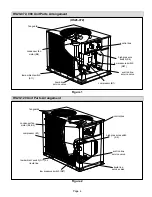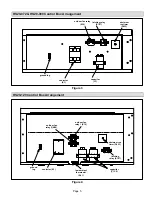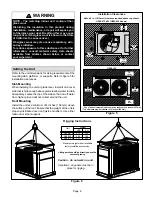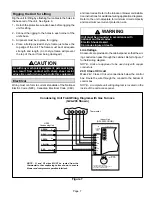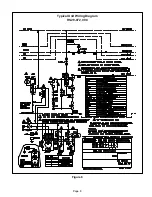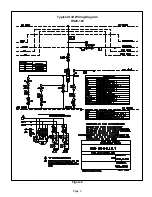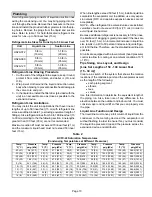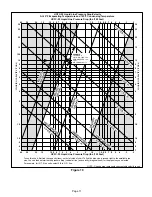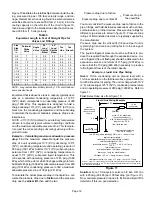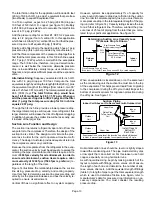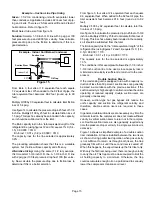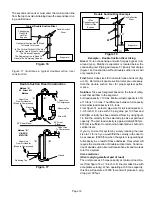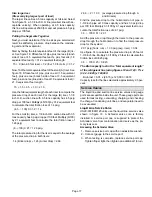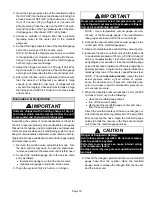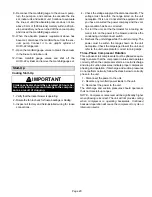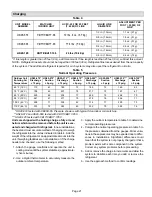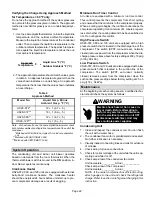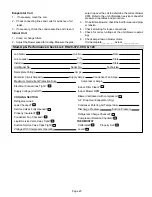
Page 18
Liquid And Suction Line Service Valve
(Valve Open)
Schrader
valve
service
port
service port
cap
insert hex
wrench here
to indoor coil
to outdoor coil
stem cap
Schrader valve open
to line set when valve is closed
(front seated)
service
port
service
port cap
stem cap
insert hex
wrench here
Liquid And Suction Line Service Valve
(Valve Closed)
(valve front seated)
to outdoor coil
to indoor coil
Figure 19
Opening the Liquid Line Service Valve:
1 − Remove stem cap with an adjustable wrench.
2 − Use a service wrench with a hex−head extension to
back the stem out counterclockwise as far as it will go.
3 − Replace the stem cap. Tighten finger tight, then tighten
an additional 1/6 turn.
WARNING
Do not attempt to backseat this valve. Attempts to
backseat this valve will cause the snap ring to ex
plode from valve body under pressure of refrigerant.
Personal injury and unit damage will result.
Closing the Liquid Line Service Valve:
1 − Remove stem cap with an adjustable service wrench.
2 − Using a service wrench with a hex−head extension, turn
the stem clockwise to seat the valve. Tighten firmly.
3 − Replace the stem cap. Tighten finger tight, then tighten
an additional 1/6 turn.
All units are equipped with a full service ball valve, as
shown in figure 20. One service port that contains a
Schrader valve core is present in this valve. A cap is also
provided to seal off the service port. The valve is not re
buildable so it must always be replaced if failure has oc
curred.
Opening the Suction Line Service Valve: 090 and 120
1 − Remove the stem cap with an adjustable wrench.
2 − Using a service wrench, turn the stem counterclock
wise for 1/4 of a turn.
3 − Replace the stem cap and tighten it firmly.
Closing the Suction Line Service Valve: 090 and 120
1 − Remove the stem cap with an adjustable wrench.
2 − Using a service wrench, turn the stem clockwise for 1/4
of a turn.
3 − Replace the stem cap and tighten firmly.
Suction Line (Ball Type) Service Valve
(Valve Open)
Schrader Valve
Service Port
Stem Cap
Stem
Use Adjustable Wrench
Rotate Stem Clockwise 90° To Close
Rotate Stem Counterclockwise 90° To Open
Ball
(Shown Open)
To Outdoor Coil
To Indoor Coil
Service Port Cap
Figure 20
Leak Testing
After you have connected the line set to the indoor and out
door units, check the line set connections and indoor unit
for leaks.
WARNING
Never use oxygen to pressurize refrigeration or air
conditioning system. Oxygen will explode on con
tact with oil and could cause personal injury. When
using a high pressure gas such as nitrogen or CO2
for this purpose, be sure to use a regulator that can
control the pressure down to range of 1 to 2 psig (6.9
to 13.8 kPa).
Using an Electronic Leak Detector or Halide
1 − With both manifold valves closed, open the valve on
the HCFC22 cylinder (vapor only).

